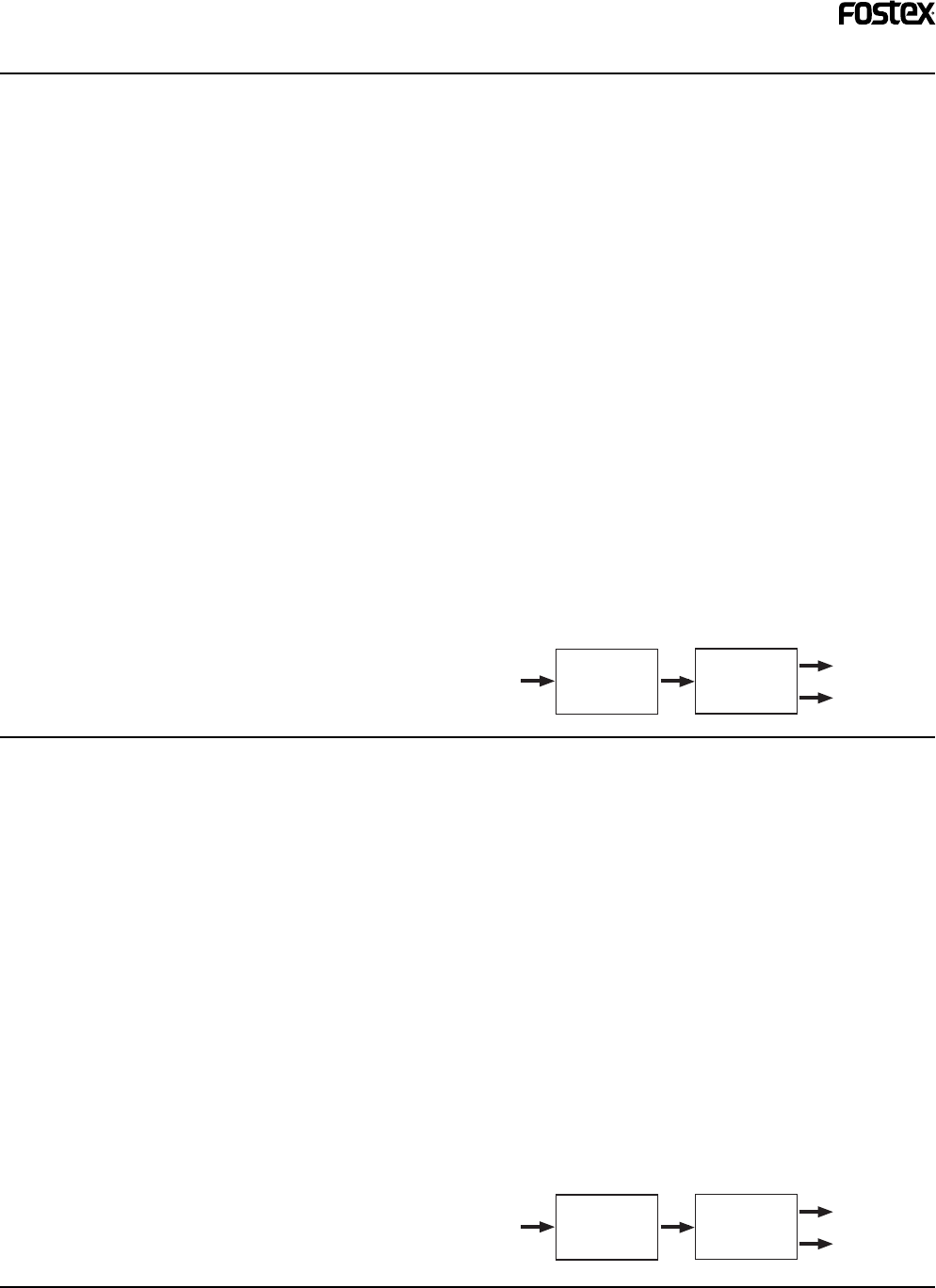
13
DE-10 Owner’s Manual
• DISTORTION
DIST-1 (Distortion) : You can get a hard distortion like driving a three-stacked amplifier.
DIST-2 (Rhythm) : You can get a slight distortion when picking the guitar strongly.
DIST-3 (Over Drive) : You can get a smooth distortion like driving a tube amplifier.
DIST-4 (Acoustic) : You can get an electric-acoustic guitar sound.
DIST-5 (Blues) : You can get a fat overdrive sound.
DIST-6 (Fuzz) : You can get a rough sound with a fat low frequency range.
DIST-7 (Lead) : You can get a bright and smooth distortion.
OUTPUT 1 (L)
OUTPUT 1 (R)
Gate
Amp Simulate
INPUT 1
• AMP SIM (Amplifier Simulation)
AMP SIM-1 (British 800 Amplifier) : Simulates the 800-series British tube amplifier, a synonym for “rock.” The king of the rock
sound of the 80’s hard rock and heavy metal. Distorted raging sound.
AMP SIM-2 (Tremo Recti Amplifier) : Simulates the American combo model amplifier, designed to get high gain sound for the
90’s hard rock and heavy metal. Fat bass and raging distorted sound.
AMP SIM-3 (Metal Panel Recti Amplifier) : Simulates the amp head of the high gain amp series, same as the Tremo Recti Amplifiers.
Deep and well-separated distortion and heavy sound. Suitable for the metal sound.
AMP SIM-4 (British Class A30 Amplifier) : Simulates a most popular British sound tube amplifier. The preamp section is designed
using the class A circuit for creating the fat and warm sound. Usually used in the range
between clear and crunch sound, but sometimes used with the higher gain to get a
harder distortion.
AMP SIM-5 (Fat Bass Amplifier) : Simulates the American combo amplifier designed as a bass amplifier but used by many
guitarists because of its fat presence sound. Suitable for jazz and blues with its clear and
crunch sound, however, because you can get a raging distortion that you cannot expect
from an ordinary bass amplifier when raising the gain. It can be used for a wide range of
genres.
AMP SIM-6 (Kick) : You can distort a kick sound appropriately.
AMP SIM-7 (Snare 1) : You can distort a snare sound appropriately.
AMP SIM-8 (Snare 2) : You can distort a snare sound excessively.
AMP SIM-9 (Voice 1) : You can get a smooth distortion.
AMP SIM-10 (Voice 2) : You can get a boomy and bright distortion.
AMP SIM-11 (Radio Voice) : You can get a bullhorn sound.
* [EFFECT 1_ADJUST] knob (PARAM.1): Adjust the Distortion Gain.
* [EFFECT 2_ADJUST] knob (PARAM.2): Adjust the Distortion Output Level.
* [EFFECT 2_MIX] knob (PARAM.3): Adjust the Gate Threshold.
• MIC SIM (Microphone Simulation)
MIC SIM-1 (Trad Condenser 3k, Low Cut: Off) : Simulates the sound of a multipurpose professional condenser microphone with a large
diaphragm. Its warm and transparent sound is suitable for a vocal, as well as a drum
overhead or guitar amplifier.
MIC SIM-2 (Trad Condenser 3k, Low Cut: On) : Simulates the sound of “MIC SIM-1” above with the Low Cut switch to On. You can
suppress boosted low frequencies as a result from placing a microphone in close
proximity to the signal source.
MIC SIM-3 (Trad Condenser 414, Low Cut: Off) : Simulates the sound of one of the most popular condenser microphones in professional
studios together with the Classic condenser 87. You can get a high-fidelity clean sound of
an acoustic piano.
MIC SIM-4 (Trad Condenser 414, Low Cut: 150Hz) : Simulates the sound of “MIC SIM-3” above with the Low Cut switch to On. You can
suppress boosted low frequencies.
MIC SIM-5 (Trad Dynamic 112) : Simulates the sound of a dynamic microphone suitable for a kick. You can get a clean and
powerful sound by applying it to a kick or bass. It has a slightly boosted low frequencies.
MIC SIM-6 (German Dynamic 421) : Simulates the sound of a dynamic microphone which is frequently used for recording a
tom-tom. Suitable for recording a skin percussion because of its powerful attack feeling
with a high frequency peak.
MIC SIM-7 (German Dynamic 421, Low Cut: 2) : Simulates the sound of “MIC SIM-6” above with the Low Cut switch to On. You can
suppress boosted low frequencies more than “MIC SIM-6”.
MIC SIM-8 (German Dynamic 421, Low Cut: SPE) : Simulates the sound of “MIC SIM-6” above with the Low Cut switch to On (SPE). You can
considerably suppress boosted low frequencies. Suitable for a speech.
MIC SIM-9 (Modern Condenser 2) : Simulates the sound of a modern condenser microphone which has a wider dynamic
range and bright sound. It offers a warm tube sound, making a vocal or acoustic guitar as
if it were recorded by a condenser microphone.
MIC SIM-10 (Vintage Condenser 47) : Simulates a professional tube microphone with a large diaphragm that offers clean and
dry sound. Suitable for an acoustic guitar and brass.
MIC SIM-11 (Vintage Condenser 87, Low Cut: Off) : Simulates the sound of a classic and historic model used for vocals and strings
frequently in professional studios. Provides outstanding warm sound among condenser
microphones.
* [EFFECT 1_ADJUST] knob (PARAM.1): Not used.
* [EFFECT 2_ADJUST] knob (PARAM.2): Adjust the Distortion Output Level.
* [EFFECT 2_MIX] knob (PARAM.3): Adjust the Gate Threshold.
OUTPUT 1 (L)
OUTPUT 1 (R)
Gate
Mic Simulate
INPUT 1


















